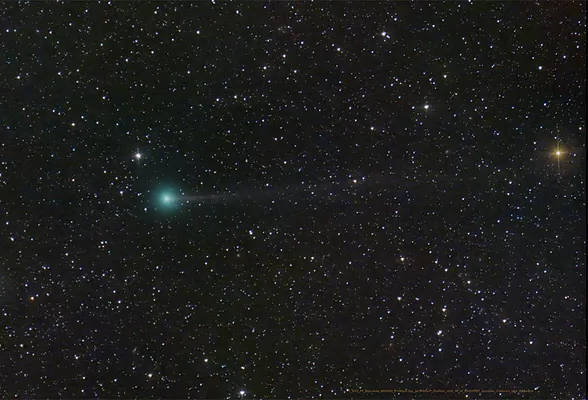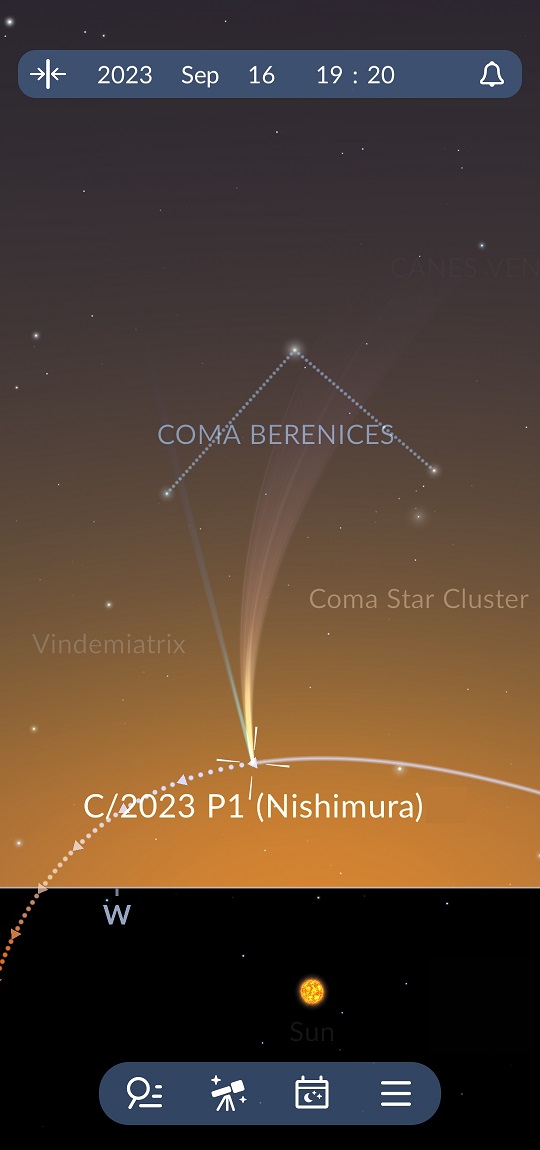At the end of January, comet C/2022 E3 (ZTF) approached the Earth. Under conditions of a fairly dark night sky, attentive observers even saw it with the naked eye, and the media even managed to declare it “the brightest comet of the year”. However, this time, the prediction turned out to be wrong: on August 12, Japanese astronomer Hideo Nishimura discovered a new “tailed star”; it is highly likely to become even brighter. However, the conditions for its observations will be much worse.
The comet received the designation C/2023 P1. On the day it was discovered, it had a brilliance of about the 11th magnitude, so it was already available to relatively small telescopes. Astronomers have not detected such bright objects for a long time. Analysis of the comet’s orbit showed that for three months before the discovery, the “tailed guest” moved along the celestial sphere, not moving away from the Sun by more than 30°. Automatic telescopes, constantly searching for new bodies of the Solar System, do not survey this part of the sky, and numerous “comet hunters” also ignore it. That’s why Comet Nishimura went unnoticed for so long. Calculations also showed that it would pass its perihelion at a distance of 0.221 AU (33 million km) from our luminary on September 17, and its angular distance from it on that day would be only 12°.

Here it is worth remembering that 12° is the depth of the Sun’s immersion under the horizon, at which nautical twilight ends and astronomical twilight begins. It is then that observations of most celestial bodies can begin. Accordingly, in the morning, at the same “depth” of the Sun, they have to be completed. Every day these moments will shift by about 2 minutes: in the morning — “forward” (i.e. twilight will start a little later every next morning), in the evening — “back”. It is clear that in the eastern part of Ukraine, twilight begins and ends earlier than in its center, and in the western part, respectively, later.
On September 6, comet Nishimura will pass near the 4th magnitude star Alterf (λ Leo). It will be visible in the morning, 16° to the left of the bright Venus. At the end of astronomical twilight, it will be 13° above the horizon, which, with a clear sky, is quite enough for successful observations, given that the visible brilliance of the “tailed star” on this day will reach the 6th magnitude. In the best conditions, it would already be visible to the naked eye, but in reality, it will have to wait a few days. It is safer to use at least a small pair of binoculars with an increase of 10-15 times. In addition, the first week of autumn, observers will be hampered by the Moon, which will pass the phase of the last quarter on September 7. On September 9, the comet will be 0.6° south of the star ζ Leo, having a brightness of more than 5°, but its height above the horizon at the appropriate time will be slightly more than 9°.

On September 12, C/2023 P1 will pass at a distance of 0.838 AU (125 million km) from Earth — this will be its closest approach to us in its current appearance. On this day, it will rise a few minutes before the end of astronomical twilight, but since dawn comes gradually and even in the middle of nautical twilight the sky is quite dark, it can be observed for some time. It is interesting that in the middle latitudes of the Northern Hemisphere — and therefore in Ukraine — almost the best conditions will develop for this. Due to the fact that the declination of the comet will be greater than the solar one, even at relatively small distances from our luminary, it will rise before it and become visible.
On September 13, the right ascent of comet Nishimura will exceed the corresponding coordinate of the Sun, and it will “crawl” from the morning sky to the evening sky. Since its brightness by that time, according to predictions, will increase to the 3rd magnitude, you can try to find it at about 08:00 p.m. GMT+3 at 3° above the northeastern part of the horizon. Binoculars with a large field of view will greatly facilitate the search. The next evening, the comet will pass less than a quarter of a degree from the star Denebola (β Leo, 2ᵐ), but it will be more difficult to see it: when the Sun drops 8° below the horizon, the height of the “tailed guest” will be only 4°. In the future, its visibility conditions will only worsen, despite the fact that its brightness will continue to grow until the perihelion on September 17. But after the 20th, the declination of the comet will become less solar, so only residents of the equatorial regions and the Southern Hemisphere of our planet will be able to observe it.
Movement of comet Nishimura through the central part of the Solar System
When will comet Nishimura next return to the inner regions of the Solar System? Thanks to a detailed analysis of images obtained by other telescopes, it was possible to detect a picture of this celestial body taken on January 19, 2023. This made it possible to clarify its orbital period, which turned out to be approximately 435 years. Interestingly, the comet orbits the Sun in the direction opposite to the direction of motion of the large planets (inclination 132.5°), and its orbit is located in such a way that it is potentially able to approach the Earth up to a distance of 0.078 AU (11.7 million km). Such an approach would have occurred if the “tailed star” had passed the perihelion three months later. Then the conditions for its observations would be perfect, and it would shine in our sky as a zero-magnitude star, similar to the bright comet Hyakutake of 1996. But… everything turned out the way it did, and in its current appearance, C/2023 P1 will be quite a difficult target for astronomy enthusiasts.
Follow us on Twitter to get the most interesting space news in time
https://twitter.com/ust_magazine
